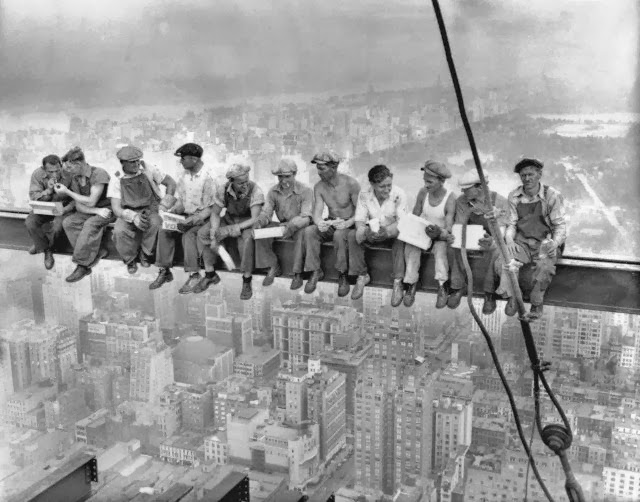Written by Max Thornton.
“At the height of the Great Depression, eleven ironworkers sit side by side on a steel beam, eating lunch. Central Park stretches out behind them as they rest, boots dangling eight hundred feet over the sidewalk of Fiftieth Street. Just a bunch of regular guys. Just another working day.”
What makes a good photograph?
What is the essence of New York City?
What role do iconic images play in the public consciousness?
What stories can they tell?
These are some of the questions raised by Seán Ó Cualáin’s thoughtful documentary Men At Lunch, which investigates one of the most recognizable American photographs of the twentieth century. At an economical 67 minutes, the film is lean, but far from weightless: this single image is the center from which multiple lines of fascinating inquiry spiral outward. The movie explores each aspect of and in the photo – the metadata of the photograph’s origins, the context of 1930s New York City, the industry of skyscraper building, the economic and social situation of the time, the tragic contemporary resonances in a post-9/11 world, immigrant lives – but takes care to center the people at the heart of it, anonymous though they are.
The practicalities of the photo’s history are dispensed with fairly quickly. The probable identity of the photographer, the current whereabouts of the original negative, and the fact that it was a staged publicity still rather than a naturalistic shot are all mildly interesting, but it’s much more engaging to turn to the question of what the picture means to people in all walks of life.
 |
| Source |
Ó Cualáin interviews historians who have investigated the photo, street vendors who sell prints of it to tourists, a sculptor who built a large model of it, present-day ironworkers who are inspired by it, and some of the far-flung individuals who are firmly convinced that among the eleven sit one or more of their own relatives. The kaleidoscope of meanings read into this one image could be seen as a microcosm of the United States as a whole, and indeed the world portrayed by the photo exemplifies the best and the worst faces of US society simultaneously.
Lunch atop a Skyscraper first appeared in the New York Herald Tribuneon October 2 1932, when unemployment was at an eye-watering 24%. Nor were the ironworkers, in paid employment far above the city streets, immune to the high cost of a capitalist society: apparently skyscraper developers of the time budgeted for one dead worker per ten floors of building. On the other hand, the picture is almost propaganda in its idealized portrayal of the American dream of the city as melting pot, the aspirational immigrants hard at work to build something lasting and to contribute something tangible to the diverse society of which they have voluntarily become a part.
If the film has a weakness, it would be its elision of the true complexities of the melting pot myth. An honest narrative of immigration to the United States really should make mention of this nation’s foundational genocide of native peoples, as well as the ongoing tensions of anti-immigrant prejudice and the marginalization of hybrid identities.
 |
| Am I a man, or am I a muppet? |
Aside from this oversight, however, Ó Cualáin has put together a charming, thought-provoking film which finds remarkable depth and power in an over-familiar image, exploring wide-reaching ramifications but never losing sight of its titular men at lunch.
Most striking, perhaps, are the connections made by this photograph and the people it portrays. Contemporary workers see their own faces there. Others are absolutely convinced they see their relatives there, and clearly in some sense they do. The fact that these men are famous – iconic, reproduced, parodied the world over – and yet their identities are unknown exemplifies not only “the great American immigrant story” of a nation at once reverent and forgetful of its roots, but also their particular role as the architects of a skyline. As one interviewee puts it: “They put their lives and their bodies into the buildings, and how strange that they’re the ones we forget.”
Max Thornton blogs at Gay Christian Geek, tumbles as trans substantial, and is slowly learning to twitter at @RainicornMax.He lives near New York now. It’s awesome.

